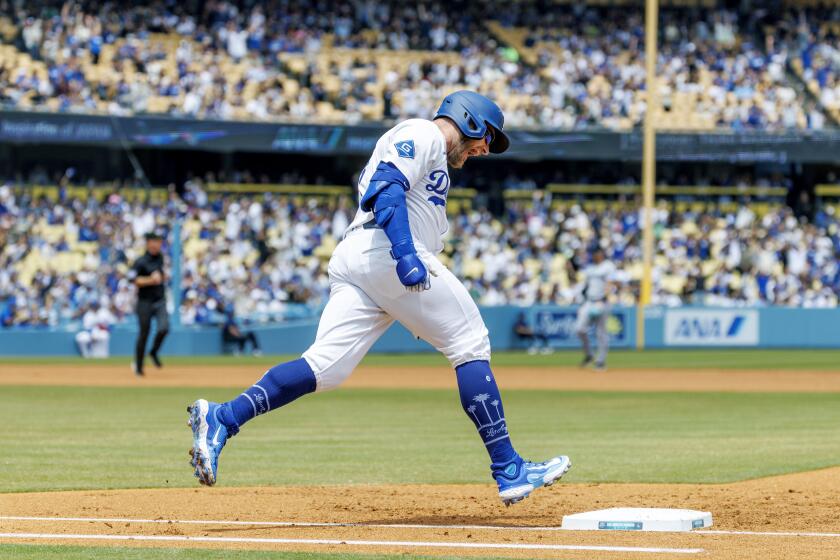He Prefers Substance Over Style
- Share via
There is no right way to hit a baseball. Some years ago, I was sitting in a press box watching batting practice on the field below. On my lap I had one of those “How To” books published by Sports Illustrated. It instructed you how to hold the bat, how to take your stance, which foot to hit off, and so on.
I looked down on the field at the batter in the box. He was doing everything wrong. He was crouched, he held the bat in the air well out of the hitting zone, he seemed almost off-balance.
It was No. 6 on the St. Louis Cardinals--a number since retired, since it belonged to a man who hit .331 lifetime with 475 home runs and 3,630 hits. No. 6 was Stan Musial.
So much for baseball theory.
Not too many years ago, a scout who shall go unnamed pointed to a Dodger rookie in the batting cage. “Look at him. He stands there not moving like a guy waiting for a bus. He’ll never be able to hit that way.”
That batter was Eric Karros. Like Stan Musial, he doesn’t go by the book. Fortunately for the Dodgers.
Actually, the “book,” as usual, is in error. A pretty good striker of the ball stood upright and still at the plate. No. 5. Fellow by the name of Joe DiMaggio.
If you ask his fans what the high point of Eric Karros’ career is, they would doubtless opt for his winning the 1992 rookie-of-the-year award.
If you ask Karros, he might say it came six months before, the night he found out the Dodgers had let Eddie Murray go (to the Mets).
If that hadn’t happened, Karros might never have had a big league rookie-of-the-year season, because he would have spent it in Albuquerque.
With Murray gone, they still didn’t hand the position to Karros. He had to beat out one Todd Benzinger and one Kal Daniels for it. That was considerably easier than having to beat out Hall of Famer Murray.
“If Murray hadn’t gone, I would have been buried,” Karros was to admit.
The Dodgers have always been lucky in their choice of first basemen. First, there was Dolf Camilli, then the elegant Gil Hodges, then Wes Parker, then the gritty and powerful Steve Garvey. There were some interregnum fill-ins. Billy Buckner held forth there briefly, Greg Brock, Franklin Stubbs, Sid Bream. No one staked a claim till Karros got the job.
Baseball lore has it that the “pennant line” runs from the catcher to pitcher through the middle of the infield to center field. But it makes a detour to first base. Check a Lou Gehrig, Willie Stargell or the great home-run hitters, Hank Greenberg, Jimmie Foxx.
So, when the Dodgers floundered earlier this year with a lineup that, on paper, looked like the class of the league, the sideline mechanics knew exactly which cylinder was missing: the first baseman.
The Dodgers count on Karros, not for high average, flawless fielding or speed on the basepath, but for game-winning hits, enemy back-breakers. In 1995, he had 18 of them, including eight home runs. Last year, it was his game-winning home run against San Francisco that effectively put the Dodgers in the playoffs.
It wasn’t that he wasn’t having a Karros year this year. He was hitting eight points above his lifetime average (.264), he was leading the team in homers (20) and runs batted in (60-something) but it wasn’t until the recent Colorado series that he turned into the cleanup hitter the league has come to know and fear.
In Monday’s game, the lineup was fattening averages on Rocky pitching (and the oxygen-debt air). Todd Zeile had four hits including two home runs, Mike Piazza had four hits including a home run, Brett Butler had four hits including a double. Even Colorado’s Larry Walker helped himself to four hits.
Eric had gone 0 for 5 in the midst of this extra-base orgy when he came up in the 10th inning and socked a game-winning home run, his 21st. Now, one for six doesn’t look all that great in the box score, but it had chipped a game off the Giants’ division lead.
Karros may not look all that dangerous in the batter’s box to a scout, but he looks like a guy in a dark alley with a switchblade to an opposing pitcher.
“I am more of a situation hitter,” Karros conceded as he sat at his locker changing his shirt the other night. “I like it when I come up and there’s no place to put me.
“I’ve never hit .300 up here [Note: He hit .298 in 1995]. I’ve always been a late-inning hitter. Baseball is such a mind game anyway. I’m aware of who’s around me in the lineup, I know Mondy [Raul Mondesi] is going to be aggressive, he’ll tempt the pitcher to waste pitches. Mike [Piazza], who bats ahead of me, is going to take pitches.
“I have to be patient and see what he [the pitcher] is going to offer me. I try to be patient at the plate. But you have to be careful you don’t become too passive up there.
“What do I hit best--curve or fastball?” He laughs. “I hit mistakes.
“Pitchers can have a lapse too. You have to wait for one. Oh, and then hope you don’t foul it off.” He laughs again.
The stance? “Two things you have to be at the plate--comfortable and confident. That’s what I try to be.”
Well. If it was good enough for Joe DiMaggio. . . .
More to Read
Are you a true-blue fan?
Get our Dodgers Dugout newsletter for insights, news and much more.
You may occasionally receive promotional content from the Los Angeles Times.










